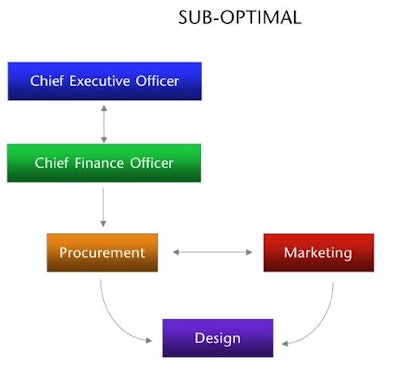
Several months ago a well respected, Fortune 500 consumer products corporation asked its brand identity/package design leader to fire his entire staff and re-hire them under the payroll of one of its consultants. As a reward for completing this transition, the design manager was, in turn, laid off. The corporation required him to literally outsource himself out of a job.
A couple months ago a high functioning, 10-person package design department of another Fortune 500 consumer health care organization was reduced to a single, overworked person. Most recently, a global spirits company eliminated it package design management function entirely.
Downsizing and outsourcing are only some of the recent attacks on package design management. In this never-ending quest for cost efficiency, these organizations are undermining their core competencies and under valuing one of their most productive assets.
Why is package design management so often in the corporate cost-savings cross hairs? Why is the process not more highly valued and properly supported? Why are package design managers fighting to keep their jobs? The answers to these questions are rooted in three primary issues; an absence of “best practices”, a lack of autonomy, and an inability for measuring packaging’s direct financial impact.
Walk into virtually any consumer product organization and analyze how they structure their marketing function. Regardless of their size, global reach and product offerings, the vast majority of consumer product corporations organize the marketing process in the same manner. Analyze how these corporations manage procurement, accounting, and sales and chances are that these functions are also structured similarly.
However, analyze how these same organizations manage brand identity and package design process, and you’ll find virtually no two alike. Some corporate package design functions combine a small internal creative and/or production staff complemented by a team of design project managers. Others are run by small handful of overworked managers who oversee virtually every brand communications effort for an ever-increasing number of brands. Still others (and you might be surprised that they include some of the world’s largest consumer branding organizations) have one- or two-person departments doing their best to orchestrate hundreds of annual design assignments.
But a growing number of companies, like the one mentioned earlier, have no internal package design management or process. Some of these organizations outsource this function to their pre-press houses or their design consultancies. Others delegate package design management to their marketing teams, some of who have never managed a design program. Typically, marketers at these companies lack training in design management, as well as a standardized format to follow.
This certainly can’t be good for their packaging’s impact on the store shelf.
Why does this level of extreme inconsistency exist? If the brand identity and package design process is a discipline that can be tracked and measured, and if design management requires a person with a defined skill set, then why is there no industry recognized “best practice” on how the process is best structured? Certainly there must be one most effective and efficient process, but if so, then why does executive management continue to undermine its own most critical resource?
Accountability without autonomy
If there is any continuity in how corporations manage package design, these similarities exist in the limits that they play on design managers and their consultants. As a widely exhibited generality, design management has no direct link to executive management. Package design managers do not hold the purse strings, nor do they have the exclusive authority to manage design assignments. In short, package design managers too often bear all of the responsibility for the process but have little power to fund or direct it.
Few package design managers have direct control over their own project budgets. Sure, package design managers have significant input in selecting outside resources and overseeing their pricing. And yes, most creative departments have an established budget for departmental salaries and overhead. But virtually every package design assignment is funded through, and controlled by, the brand marketing team. In more cases than corporations might like to admit, the brand identity design process is delegated to junior level marketers, many of whom have little or no experience in structuring and managing a design project. As a result, package design managers and their consultants must first be on-the–job teachers, guiding their marketing teams in their new role as design project leaders.
Few consumer product corporations provide for design leadership above middle management. While some certainly chief executives understand design’s value, very few of them have risen through the ranks as creative process leaders. Even for those who’ve achieved extraordinary results as package design leaders, the career path stalls at the Senior Manager or Director level. And even then, only the most successful few maintain their positions by continually proving their value—and the value of their self-created design process—everyday.
No ROI measures
An age-old wisdom asserts that “if you can’t measure it, you can’t manage it”. One of the most important tools in establishing package design’s value—and the critical importance of those who manage it—is the ability to determine the financial return that the process generates. While all corporations can determine how much design costs, few, if any, measure its direct impact on the bottom line.
Working with about 50 consumer product corporations, Wallace Church has experienced only one with an established process to measure package design’s dollar-for-dollar financial return on investment. But these folks won’t share their data.
When asked about instituting such a measure, many design managers assert that it’s all they can do, within continually restrictive budgets and time tables, just to get the job done, no less to measure its financial value. Others suggest that the only measure that executive management cares about is stock market performance. As long as the product sells, there is no time or budget to analyze why it sells and to quantify those elements that are most critical to its success.
As a result, brand identity and package design is inexorably merged with advertising, sales incentives, retailer programs, and all other means of brand promotion, with no measure of the contribution generated by any one element. This inherently undermines package design’s value among all brand communications efforts.
New hope, new respect
Certainly, it’s not all gloom and doom for package design management. The most dramatic cost-cutting efforts will soon prove to be cuts too deep. Momentum will shift. The pendulum, having swung too far, will change its coarse, but not without the diligent effort of those dedicated package design leaders who find a way to prove their value in every project, everyday.
Those who document and promote a best practice, those who fight for more control over project budgets, those who find ways to track design’s paramount return on investment will thrive. Success will come, but only to those who, in the face of downsizing and outsourcing, can prove package design’s paramount value as the single most sales-effective marketing tool.
For more information on measuring package design’s ROI and a downloadable step-by-step methodology with real-world, global-brand case histories, read the article “Proving Our Value” in the “Brand News” section of at www.wallacechurch.com.

























